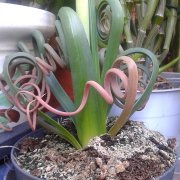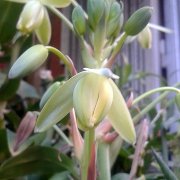Care of the bulbous plant Albuca spiralis or Corkscrew albuca |
|
The Albuca genus, of the Asparagaceae family, comprises more than 60 species of bulbous plants native to southern and eastern Africa. Some species are: Albuca spiralis, Albuca bracteata, Albuca fastigiata, Albuca humilis, Albuca shawii. Common name: Corkscrew albuca. This species is native to Western and Northern Cape Provinces, South Africa. They are deciduous bulbous plants with bulbs 5 cm (1.96") in diameter; they reach 60 cm (1.96 feet) in height when they bloom. Its curious spiral twisted leaves appear in a rosette, they are succulent and bright green. They produce a long floral stem at the end of which appear 12 yellowish flowers with vanilla aroma. They bloom in spring. These fast growing plants are used in pots or in greenhouses; in mild winter climates they are used to form borders or groups with other bulbous plants. Albuca spiralis prefers direct or very bright sun exposure. The winter safety temperature is around 5 ºC (41 ºF). The soil for these plants must be well drained and contain abundant organic matter. Water regularly in spring and summer but without watering. From autumn the watering until spring is eliminated. Fertilize with compost or manure in early spring to encourage flowering. Corkscrew albuca does not need pruning but dry leaves can be removed and the bulbs buried for the following season. Albuca spiralis is a quite resistant plant to the habitual plagues and diseases. Corkscrew albuca propagates from seeds sown in their final place in the Mediterranean climate; if the winter is cold it is better to sow them in a seedbed. They also reproduce by separating bulbs during the fall. |
Images of the bulbous plant Albuca spiralis or Corkscrew albuca |
Find plants
Albuca spiralis or Corkscrew albuca | Care and Growing
© 2025 FavThemes


